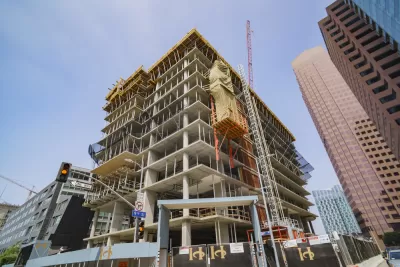Even if new housing reduces rents regionwide, scholars are divided as to when and whether new market-rate apartments reduce rents in nearby blocks. A new study seeks to answer this question.

Numerous economic studies show that cities that allow lots of new housing have lower housing costs than places with highly restrictive zoning, and thus that the anti-housing policies of cities such as New York and San Francisco (and their suburbs) contribute to regional high rents.
But even pro-housing commentators have suggested that this might not be true at the neighborhood-by-neighborhood level, at least in newly gentrifying neighborhoods. Some believe that such housing increases demand for a neighborhood, which in turn breeds gentrification, which in turn creates higher rents.
However, a new study, performed by two economists and one doctoral student,* suggests that new market-rate housing reduces rents. This study covered buildings in 11 major cities that were built between 2014 and 2016. As a proxy for gentrification, the study focused on areas where there was "no other luxury building within 500 meters." However, these areas were already wealthier than the citywide average, with rising rents and an above-average percentage of new housing built since 2010.
The study found that before construction, rents rose more rapidly within 200 meters of these new buildings than in areas 200-800 meters away. By contrast, after construction rents rose more slowly within 200 meters of these buildings. Thus, it appears that these new buildings caused rents to rise less rapidly (at a time when rents were increasing almost everywhere). Although neighborhood population increased near these buildings, the increased demand was not sufficient to raise rents.
On the other hand, this study does not necessarily prove that new housing in every conceivable neighborhood will lower housing prices. At least two questions require further research: First, do these results apply for all cities? Or is there a difference between already-expensive cities such as New York (where upzoned areas are often just a few blocks away from downzoned areas, thus funneling demand into the former set of areas) and cheaper cities such as Atlanta? Second, are the results different for lower-income neighborhoods (as opposed to neighborhoods that are middle-class or nonresidential)?
*I am happy to mention them and thus plug their work: Brian James Asquith, Evan Mast, and Davin Reed.

Planetizen Federal Action Tracker
A weekly monitor of how Trump’s orders and actions are impacting planners and planning in America.

Congressman Proposes Bill to Rename DC Metro “Trump Train”
The Make Autorail Great Again Act would withhold federal funding to the system until the Washington Metropolitan Area Transit Authority (WMATA), rebrands as the Washington Metropolitan Authority for Greater Access (WMAGA).

The Simple Legislative Tool Transforming Vacant Downtowns
In California, Michigan and Georgia, an easy win is bringing dollars — and delight — back to city centers.

The States Losing Rural Delivery Rooms at an Alarming Pace
In some states, as few as 9% of rural hospitals still deliver babies. As a result, rising pre-term births, no adequate pre-term care and "harrowing" close calls are a growing reality.

The Small South Asian Republic Going all in on EVs
Thanks to one simple policy change less than five years ago, 65% of new cars in this Himalayan country are now electric.

DC Backpedals on Bike Lane Protection, Swaps Barriers for Paint
Citing aesthetic concerns, the city is removing the concrete barriers and flexposts that once separated Arizona Avenue cyclists from motor vehicles.
Urban Design for Planners 1: Software Tools
This six-course series explores essential urban design concepts using open source software and equips planners with the tools they need to participate fully in the urban design process.
Planning for Universal Design
Learn the tools for implementing Universal Design in planning regulations.
Smith Gee Studio
City of Charlotte
City of Camden Redevelopment Agency
City of Astoria
Transportation Research & Education Center (TREC) at Portland State University
US High Speed Rail Association
City of Camden Redevelopment Agency
Municipality of Princeton (NJ)






























